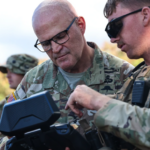
The House Armed Services Committee on Wednesday began considering its $883.7 billion fiscal year 2025 National Defense Authorization Act, to include adopting additional oversight measures for the Sentinel future intercontinental ballistic missile program that has faced cost and schedule overruns. Rep. Mike Rogers (R-Ala.), the HASC chair, noted the panel was set to consider nearly 700 amendments to the annual defense policy during the marathon markup session, which was still ongoing as of Defense Daily’s deadline. “It’s a good bill.…

 By
By 











